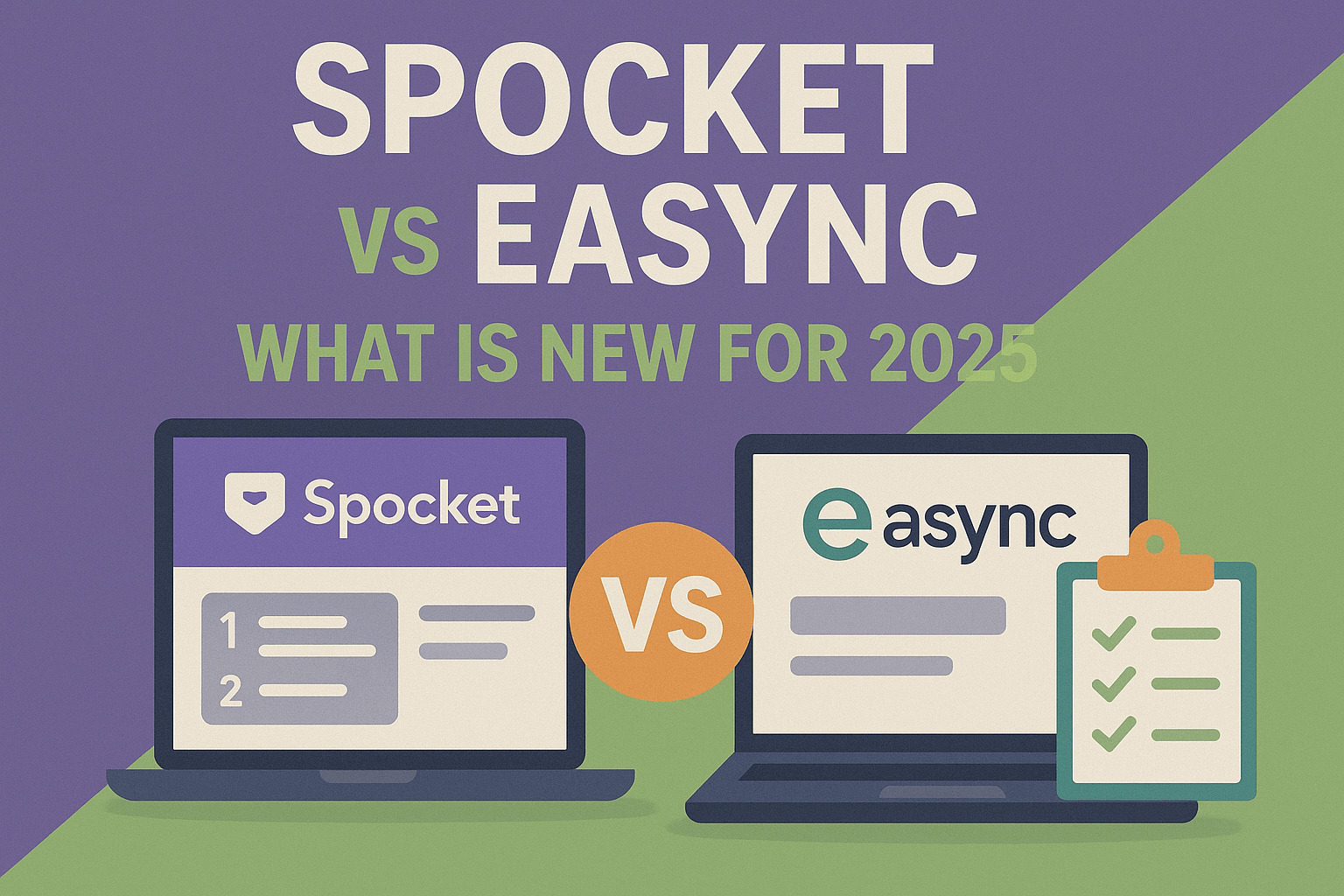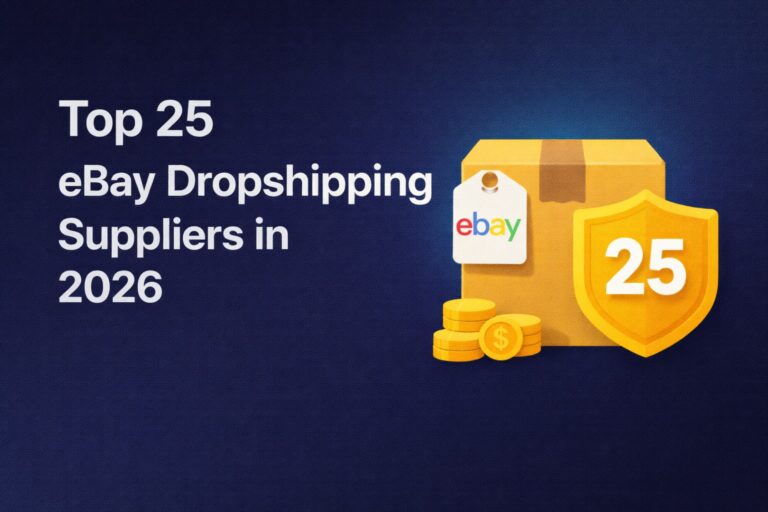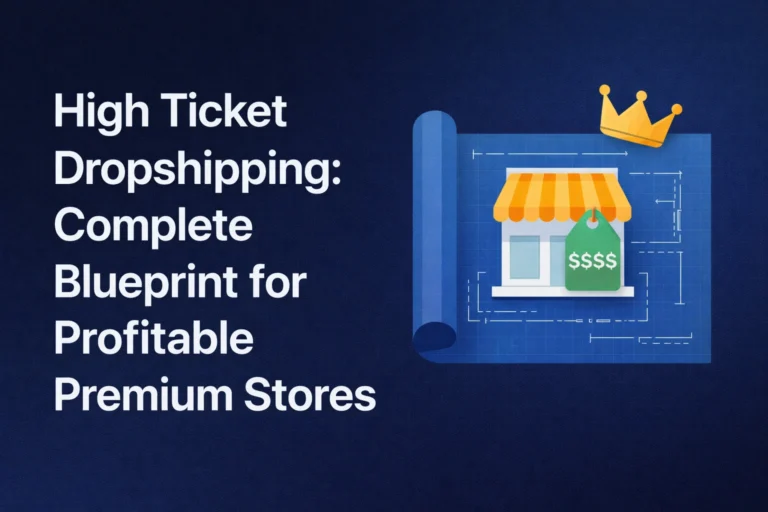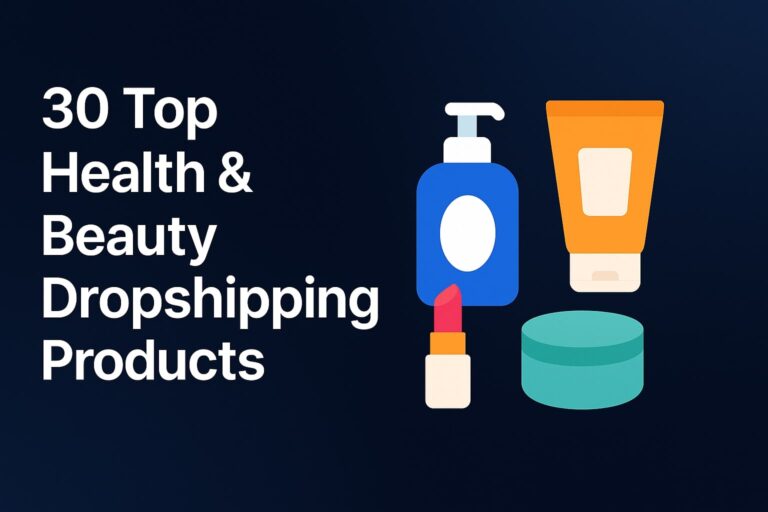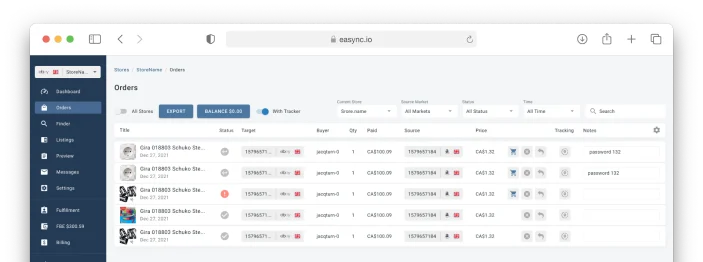A few years ago, Sprocket Dropshipping made a name for itself by offering something other platforms didn’t: shipping from suppliers based exclusively in the US and EU. That’s still its biggest selling point, but 2025 has brought some noticeable changes.
Now, alongside North American and European suppliers, you’ll also find listings from platforms like AliExpress and Temu. It’s a big shift for a company that publicly positioned itself as the anti-AliExpress.
So, have these changes turned Spocket into a global dropshipping hub? And if so, can it deliver the same speed and quality it’s known for?
In this 2025 review, we’re walking through what Spocket offers now, what it does well, and where it still lags behind. If your focus is on marketplaces like eBay and Amazon, we’ll show you why many sellers are opting for more flexible tools instead.
What is Spocket in 2025? A Quick Look Under the Hood
Spocket is a dropshipping platform built around the idea that sellers can source “quality” products from EU and US suppliers. This means it can offer faster shipping than the traditional 2-6 weeks on offer from Chinese suppliers. For this reason, it’s popular with sellers with Shopify stores who want to build branded shopfronts with a promise of short delivery times and polished listings.

As of 2025, Spocket claims to have over 60,000 merchants and offers a diverse catalog of goods across beauty, bath, tech, and fashion. Most products ship in 2-5 business days from strictly vetted US and European suppliers. For store owners big on trust and repeat buyers, that speed was Spocket’s biggest draw card.
The onboarding process is now much faster. New sellers can create a store and start importing products in just a few minutes, thanks to a setup wizard.
Spocket’s foundation still remains quality-first fulfillment. However, it has added several new tools and integrations this year to modernize how sellers get started and manage their existing stores.
Here’s what caught our attention in Spocket’s 2025 feature lineup.
1. Spocket’s Free AI-Generated Shopify Store
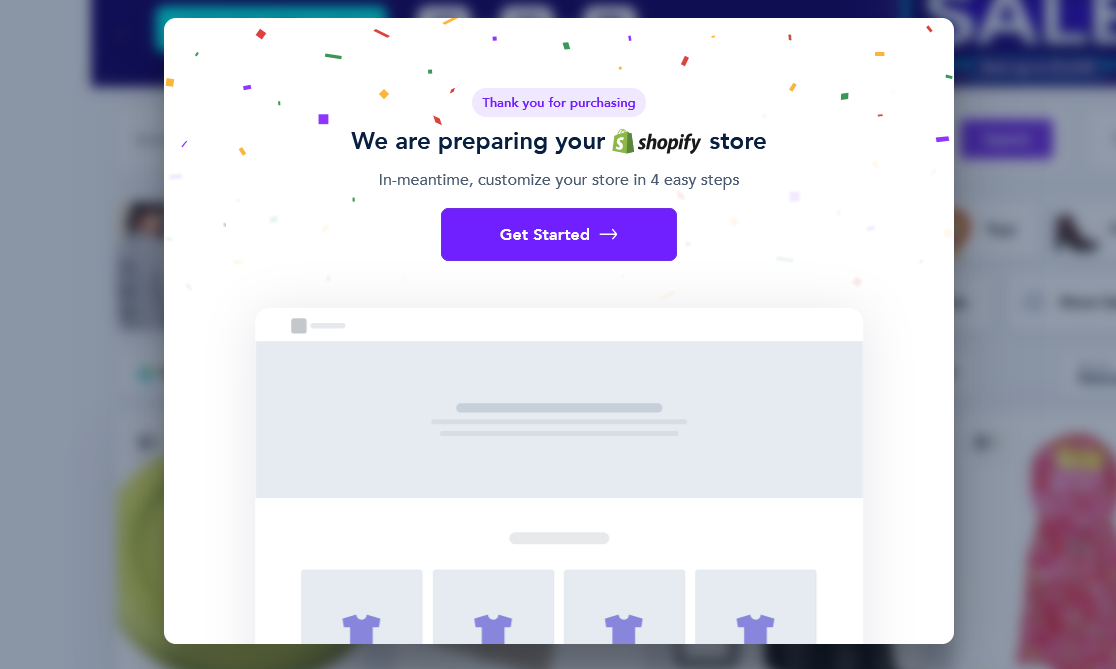
Spocket gives new sellers a fairly irresistible offer: a free and fully-generated Shopify Store. Accepting this offer means you can build a ready-to-sell Shopify store filled with products you import from the Spocket catalog.
While advanced users can build their own stores, this easy-to-use option can build you a brand new store based on options you select from the Wizard.
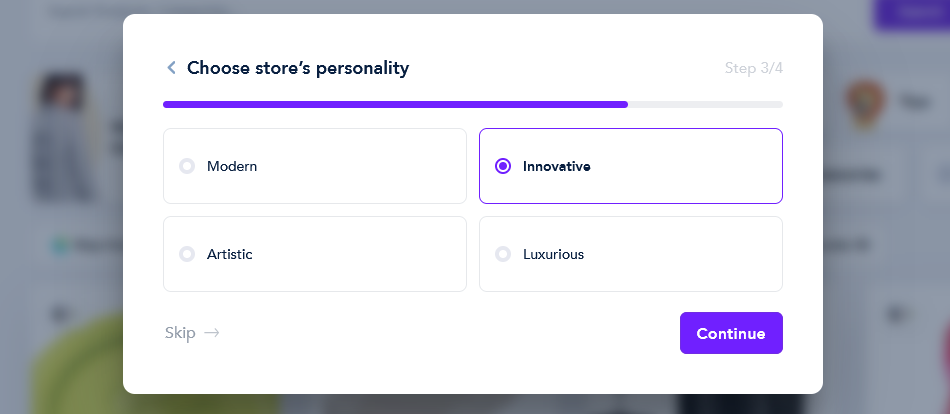
After only a few minutes of customizing your Shopify setup, Spocket transfers the new store to your email address. You can then create a new Shopify account and gain access to the store automatically connected to your Spocket account.
While graphics and layout have been created for you, you are essentially left with an empty Shopify store on a 3-day trial.
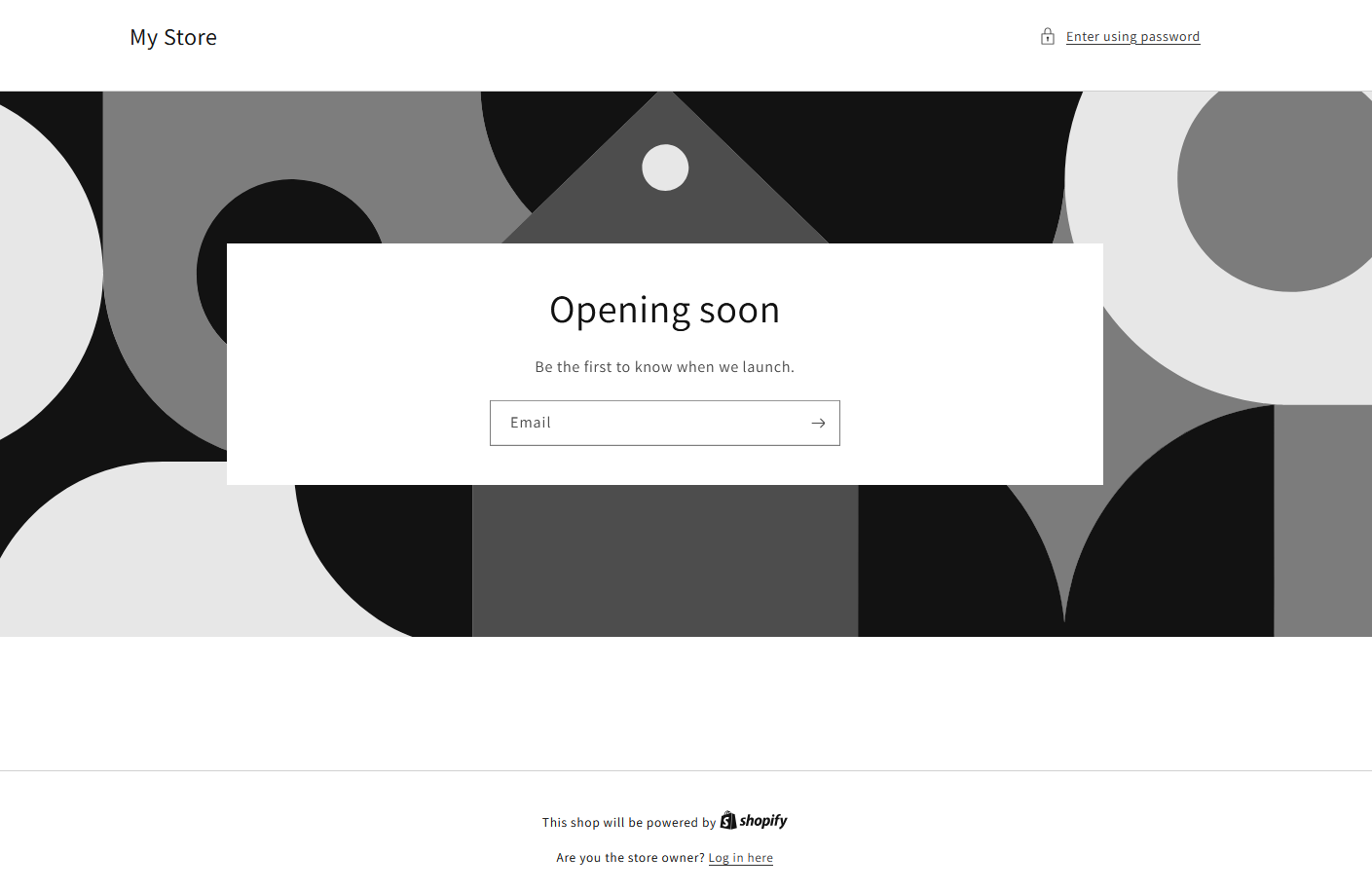
The auto-generated store is a nice touch, but it feels unfinished. The auto-generation feature currently only works with Shopify, so sellers on Amazon, eBay, or multichannel stores typically prefer a solution like Easync, which offers marketplace-ready automation natively.
2. Global Pricing Rules
Spocket now supports store-wide pricing automation. You can apply fixed markups, multipliers, or percentage-based increases to all imported items at once. An “Advanced Pricing Rules” tab lets you set volume-based pricing tiers for larger orders.

It’s quite a helpful upgrade, but one that’s locked behind paid plans. While it’s a good way to apply pricing rules across the board, there still isn’t an intelligent and competitive repricing automation feature like you get with platforms like Easync.
3. Branded Invoicing and Private Label for Beauty Products via Jubilee
On the higher-tier plans, sellers can upload logos and customer messages to invoices. This creates a more personalized and professional feel for customer orders.
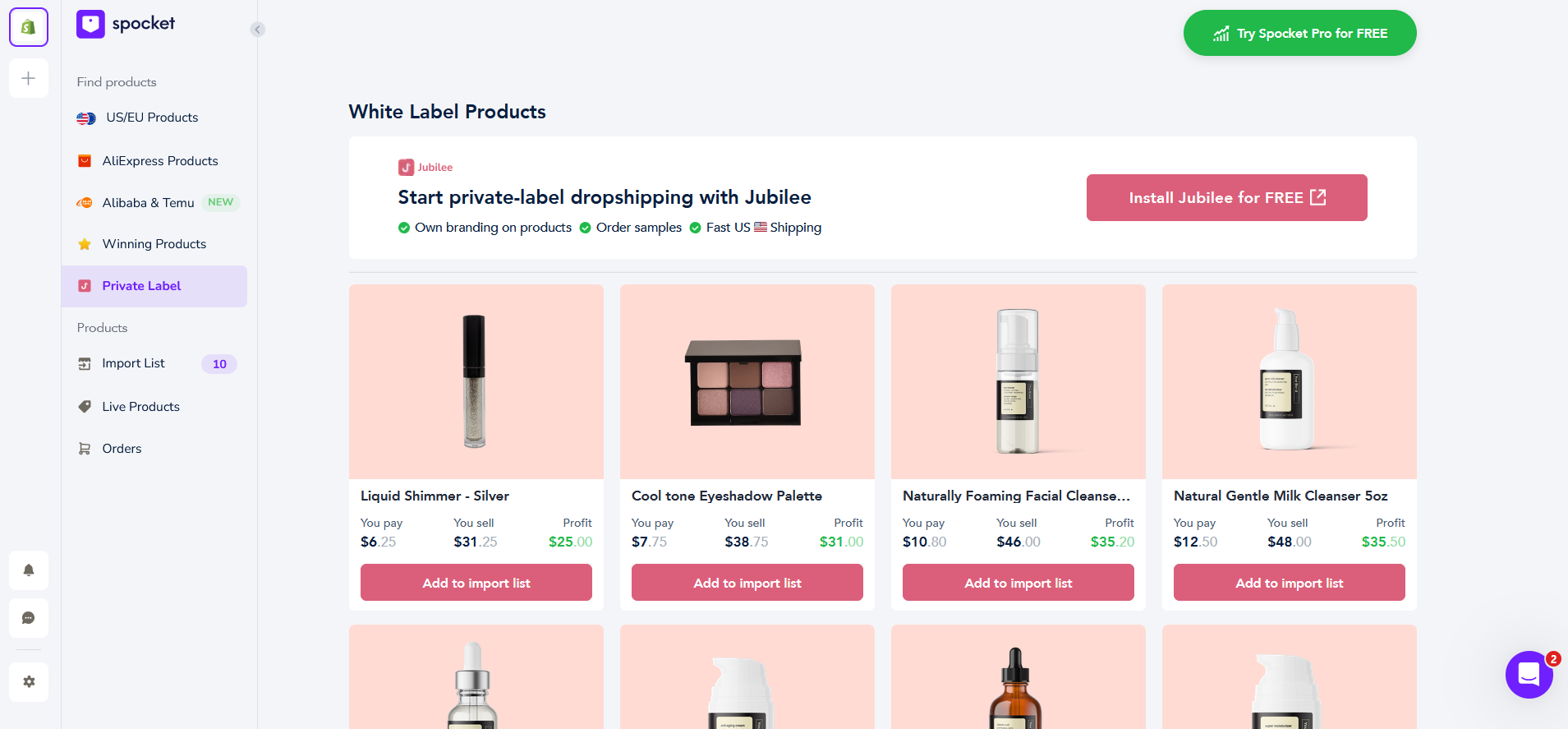
You can also explore private-label skincare and wellness products through Spocket’s integration with Jubilee Beauty. It’s a step toward branding, but complete custom packaging and unboxing experience still require a 3PL.
4. Supplier Expansion: Now Includes Temu and AliExpress
In 2025, Spocket shifted from its US/EU-only roots. Spocket now offers access to products from AliExpress, Alibaba, and Temu. However, this is an integration with a platform called AliDrop and not a native feature of Spocket.
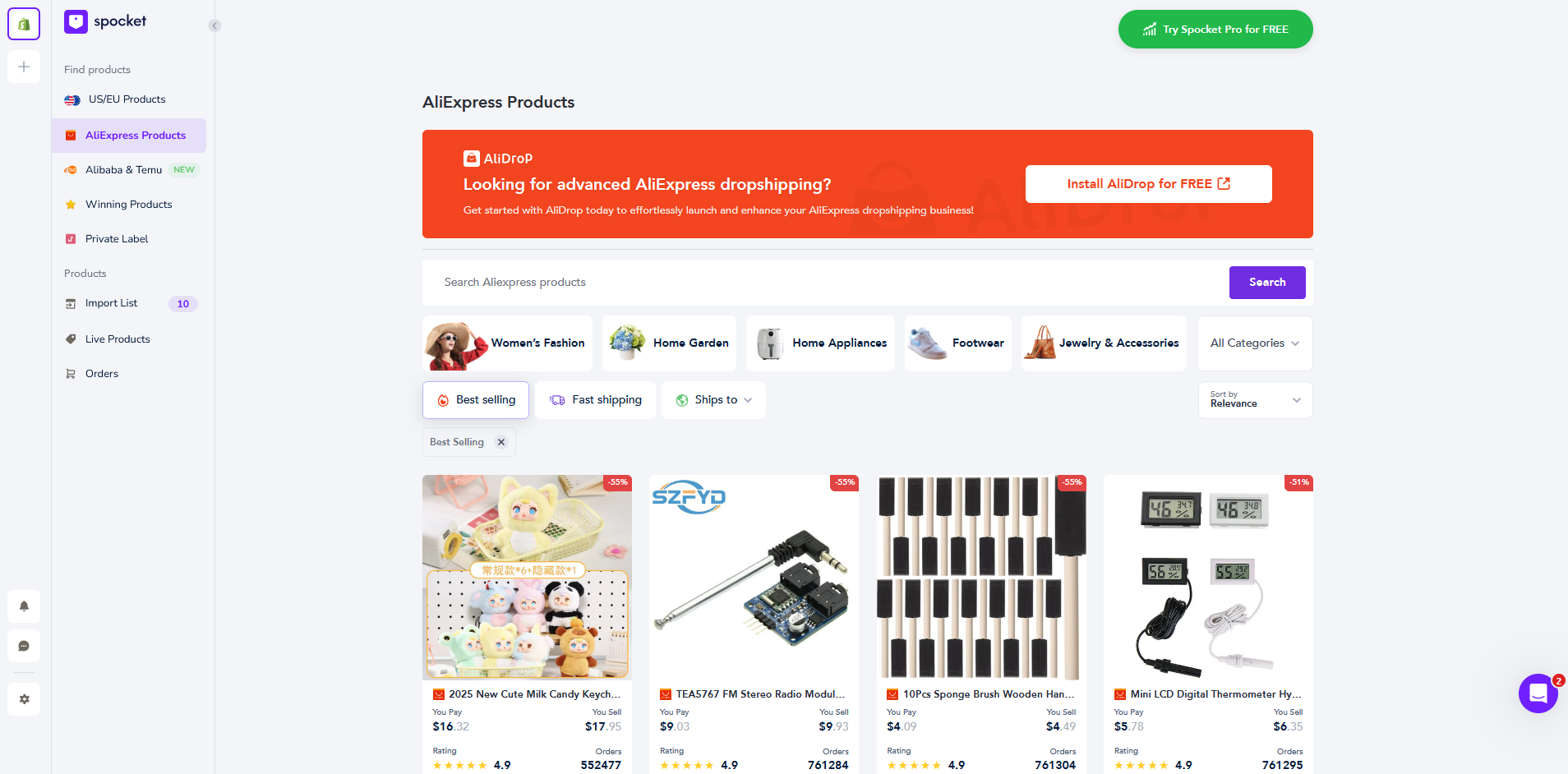
While the integration itself is smooth, sellers can only browse AliExpress items through Spocket. If you want to import items from Alibaba and Temu, you will need to purchase a plan from the AliDrop platform first—adding an unseen additional cost.
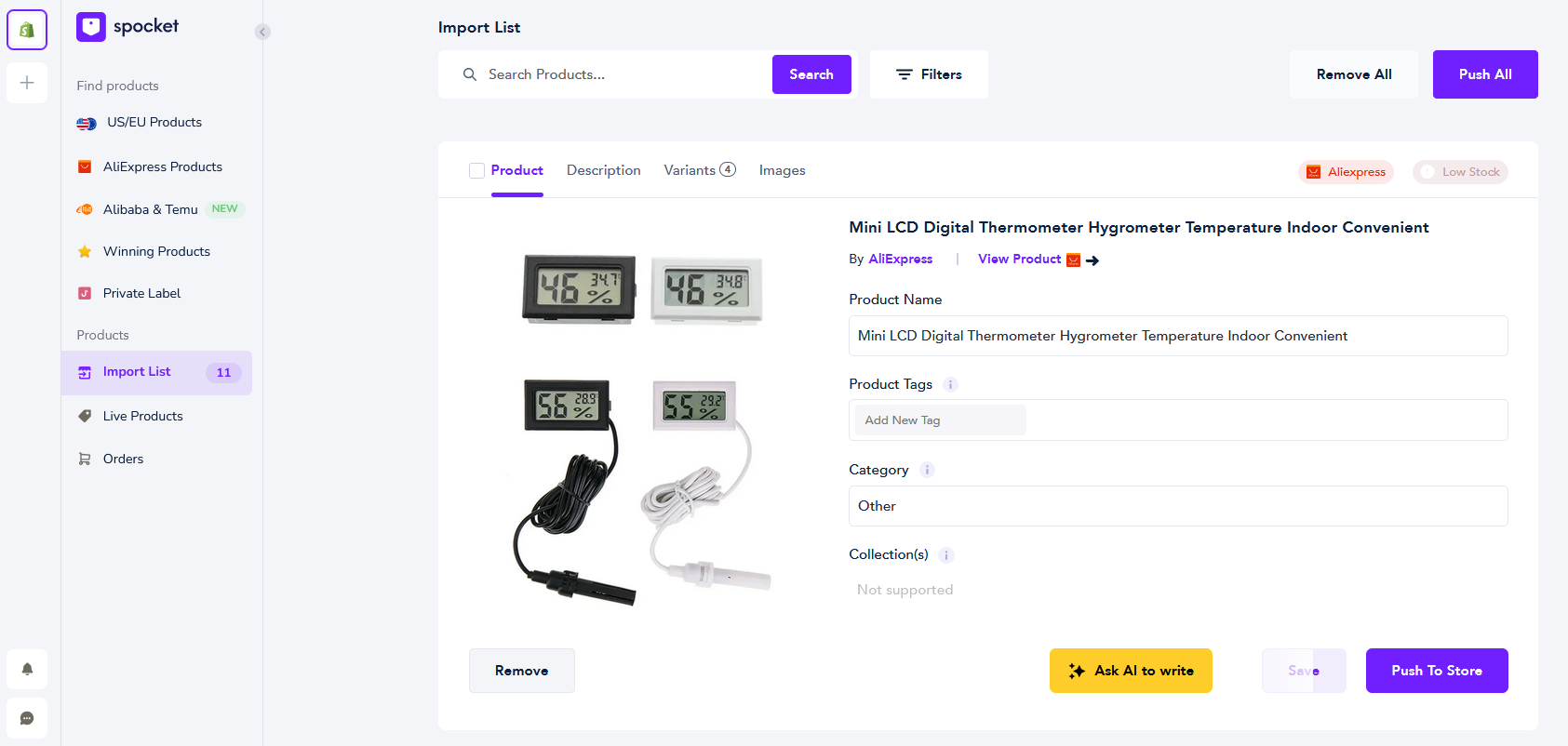
It’s useful for testing trends, or for shipping to countries like Australia that aren’t currently affected by trade tariffs and enjoy shorter shipping times from China.
Inside the Dashboard: What You Actually Get as a User
Once you’re inside the Spocket dashboard, things feel clean and well-organized. The main navigation gives you quick access to product discovery, import lists, orders, and settings. For sellers who are already used to the Shopify UI, it’s quite an easy adjustment.
Product discovery is one of Spocket’s stronger points. You can filter by category, shipping location, delivery time, cost, and supplier rating. There are even filters for premium products and another to show only listings with US shipping under $5. Sellers protecting their profit margins will find this feature handy.

Importing items from the US and EU stores is also quite straightforward. You can click to add items to your list from the catalog, find them in the import list tab, and edit titles, descriptions, pricing, and tags before pushing to your store.
You’ll find a handy feature allowing you to optimize SEO tags and descriptions with AI, however, it requires an additional subscription to the SmartLii AI platform and isn’t included in Spocket’s subscription fee.

The editing panel is a little cramped, and the description field feels like you’re using a word processor embedded inside the item tab. It works, but it’s not exactly fast.
If you’re using a lower-tier plan, expect some limitations. You’ll likely run into caps on product imports, access to branded invoicing, and the number of stores you connect. All of the lower tiers mean you will need to pay for a separate Spocket subscription for each store you add, unless you’re on the $299/month unicorn plan.
The overall UI design is simple and lacking in advanced features. However, this is precisely why many new sellers flock to the platform. Once sellers begin to open more stores and need access to more marketplaces though, Spocket begins to show its limitations.
On Easync, you can manage multiple stores across different platforms with a single account, even on entry-level pricing. Plus, Easync’s real-time inventory sync and auto-ordering make it better suited for fast-paced marketplaces like Amazon and eBay, where speed and accuracy matter more than simplicity.
Spocket Review: Pricing, Pros & Cons
Let’s take a closer look at how Spocket and Easync compare in terms of pricing and flexibility for growing your store.
Spocket Pricing (2025)

Spocket uses a tiered pricing system based on the number of products you want to sell and the features you need. Every plan comes with a 14-day free trial, but it requires a credit card and minor KYC checks to activate.
The Starter Tier does state that you can have multiple stores. However, the fine print indicates that you can manage multiple stores from a single account, but you still need to purchase a separate subscription for each store under it.
You still need to pay for a subscription per store. If you need access to features like Amazon and eBay support, branded invoicing, and access to premium products (i.e., the ones with high sales volume), you’ll need to pay significantly more.
Here are Spocket’s pricing plans, only accessible once you sign up for an account:
| Plan | Monthly Price | Product Limit | Premium Products | Branded Invoicing | Multistore | Amazon/eBay Support |
| Starter | $39.99 | 25 | ❌ | ❌ | ✅ (1-per subscription) | ❌ |
| Pro | $59.99 | 250 | 25 | ✅ | ✅ (1-per subscription) | ❌ |
| Empire | $99.99 | 10,000 | 10,000 | ✅ | ✅ (1-per subscription) | ✅ |
| Unicorn | $299.99 | 25,000 | 25,000 | ✅ | ✅ | ✅ + Bulk Checkout |
Spocket’s clean UI and quality control are definite advantages. However, the locked features and limited scaling on lower tiers can feel restrictive. This is especially true for sellers who work across multiple storefronts.
Easync Pricing (2025)

Easync takes a different approach to pricing. Each pricing plan includes full access to all tools. This includes:
- Marketplace integrations
- Product research
- Auto-ordering
- Tracking
- Bulk import tools
Instead of gating features, Easync scales based on how many listings and auto-orders you need.
| Plan | Monthly Price | Product Listings | Auto Orders | Included Features |
| Starter | $49.99 | 2,000 | 200 | All tools included |
| Progressive | $65.99 | 3,000 | 300 | Bulk tools, CSV import |
| Advanced | $79.99 | 4,000 | 400 | Premium filters and rules |
| Expert | $99.99 | 5,000 | 500 | Custom automation tools |
| Premium | $119.99 | 7,500 | 750 | High-volume selling tools |
| Business | $159.99 | 10,000+ | 1,000+ | Multistore scaling and support |
Pros and Cons: Spocket vs. Easync at a Glance
Both platforms offer useful tools for dropshippers. However, differences between the two become clear once you compare their strengths and limitations side by side:
| ✅ Spocket Pros | ❌ Spocket Cons |
|
|
| ✅ Easync Pros | ❌ Easync Cons |
|
|
How to Dropship with Spocket: Step by Step
If you’re ready to start selling online and don’t have a Shopify store yet, Spocket is an ideal place to start. Here’s a step-by-step guide on how to get up and running.
1. Sign Up and Choose Your Plan
Head over to the Spocket homepage and create an account. After logging in, you’ll be asked to select your store’s niche, region, and preferred product sources (Like US/EU suppliers, AliExpress, or full White Label). From there, you’ll need to pick a pricing plan to unlock product imports.

This can be the starter plan or something higher. Either way, have your credit card ready to start the 14-day $1.99 trial.

2. Connect Your Online Store
Spocket integrates with a range of platforms, including Shopify, WooCommerce, Wix, BigCommerce, Squarespace, Amazon, and eBay (but only on higher-tier plans). At this point, you have the option of creating a Shopify store from scratch using the Spocket AI or manually connecting your store.
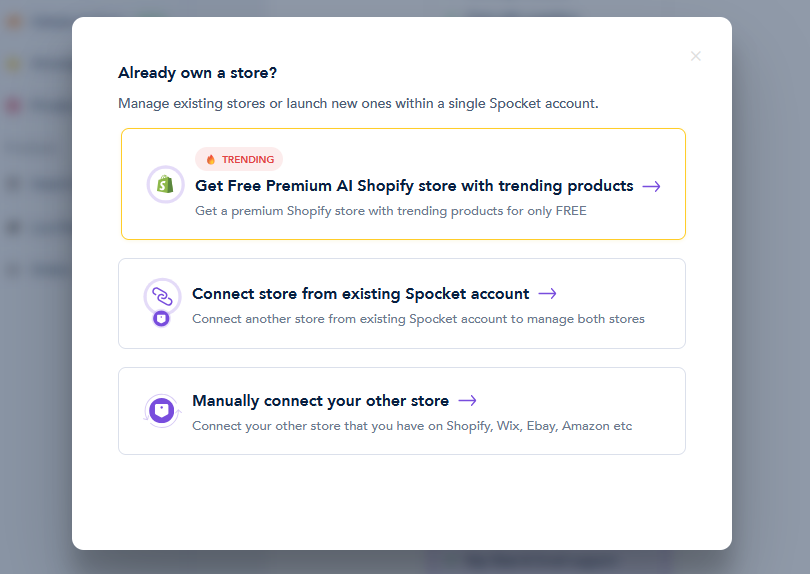
If you choose to create the Shopify store, it will take up to an hour, and you will have to accept ownership of it manually. Details are sent to your inbox using the email address you used to sign up for the platform.

Existing stores can be onboarded via URLs. Once connected, you can automatically sync product listings, orders, and inventory.
Remember: If you’re on a lower-tier plan, you can only connect to a single store.
3. Find the Right Products
Inside the dashboard, you can filter by category, supplier location, shipping speed, and pricing. There are also dedicated tabs for Premium Products and Private Label items with Jubilee Beauty.

You can click into any listing to review supplier ratings, delivery times, and profit margins.
Note: Although Spocket focuses on US and EU suppliers, you can explore Temu and Alibaba listings. Just note that shipping times for these products are significantly longer.
4. Find the Right Products
Add products to your import list and then customize them before publishing. Here you can edit titles, product descriptions, tags, categories, images, and pricing. You can also set the global pricing rules to apply automatic markups.

Once everything looks good, hit Push to Store, and the product will go live on your storefront.
5. Fulfill Your Orders
When someone places an order, Spocket pulls it into your dashboard automatically. From there, you just click to confirm, pay the base cost, and let the supplier handle the rest. Spocket also provides real-time tracking, so you and your customer can monitor delivery.
What Users Are Saying About Spocket in 2025

Spocket has positive ratings across TrustPilot, G2, and the Shopify App Store, with most users praising its automation tools and user-friendly interface.
“The automation features have saved me so much time and customer service is top-notch” – TrustPilot.
However, if you dig a bit deeper into the actual reviews, some patterns emerge. Complaints about pricing tiers and the premium product paywall are quite common.
“Products that actually sell are placed in this category. Don’t force people to pay for your premium plans.” – Shopify App Store.
A recurring issue across all review platforms is surprise billing after cancellation of the trial period. In fact, you’ll find a lengthy thread on Reddit describing this issue in fine detail. Filter for negative reviews, and you’ll find the majority of users are angrily complaining about this. Use caution if you decide to go with a free trial for Spocket.
“I canceled my Spocket subscription, but they still charged me $59.99 — even though I never used the service.” – TrustPilot.
Modern Dropshipping Strategy Tips for 2025
If you’re planning to scale your store in 2025, there are a few smart ways to stay competitive:
- Start by using supplier region filters to match your customers’ locations. The closer suppliers are to your customers, the faster shipping will be. That speed directly affects conversions and customer satisfaction.
- Stick to fast-moving categories like beauty, fitness, pet products, and smart home gadgets. These niches typically perform well and are much easier to promote through short-form content.
- If brand identity matters to you, consider working with a third-party 3PL to handle branded packaging and order fulfillment.
Remember that strategy isn’t just about your product. It’s largely about the tools at your disposal. If you’re managing multiple storefronts or need automated listing and repricing across marketplaces like Amazon and eBay, Easync gives you that control out of the box.
Finally, don’t just rely on Shopify. Expanding to eBay, Amazon, or niche marketplaces helps diversify risk and unlock customer segments you probably didn’t even know existed.
Final Verdict: Should You Use Spocket in 2025?
Spocket, known best for its fast US and EU shipping, supplier vetting, and user-friendly experience, can be a good fit for new sellers. It’s also an ideal place for Shopify store owners who want to create polished and branded stores quickly.
However, for sellers who plan to go beyond a single storefront or need advanced features like real-time automation and multiplatform sync, Easync remains the more flexible and scalable long-term solution.
Try Easync today with our no-lock-in 7-day trial. We give you plenty of room to see if it meets your 2025 dropshipping expectations.
FAQs
What is Spocket in 2025?
Spocket is a dropshipping platform that connects sellers with vetted suppliers in the US and EU for faster, higher-quality product fulfillment. Recently, Spocket has added AliExpress and Temu to its supplier offerings.
Can I use Spocket with eBay or Amazon?
Yes, but only on the highest-tier plan. Each store requires a separate subscription across all paid plans.
What’s the best alternative to Spocket for multichannel sellers?
If you need full automation, real-time sync, and support for multiple storefronts like Amazon, eBay, and Shopify, Easync is an ideal alternative to Spocket.
Noah Edis is a freelance writer and systems engineer with a wealth of experience in modern hardware and software. When he’s not working on his latest project, you can find him playing competitive dodgeball or pursuing his personal interest in programming. At Easync, Noah helps thousands of sellers optimize their eBay and Amazon businesses by providing automation tools and practical guidance on account health, pricing, and inventory management.
